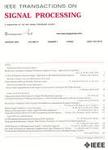版权所有:内蒙古大学图书馆 技术提供:维普资讯• 智图
内蒙古自治区呼和浩特市赛罕区大学西街235号 邮编: 010021

作者机构:Univ London Imperial Coll Sci Technol & Med Dept Elect & Elect Engn London England Swiss Fed Inst Technol Audio Visual Commun Lab CH-1015 Lausanne Switzerland Univ Calif Berkeley Dept Elect Engn & Comp Sci Berkeley CA 94720 USA
出 版 物:《IEEE TRANSACTIONS ON SIGNAL PROCESSING》 (IEEE Trans Signal Process)
年 卷 期:2003年第51卷第5期
页 面:1306-1323页
核心收录:
基 金:Audio-Visual Communications Laboratory Swiss Federal Institute of Technology Schweizerischer Nationalfonds zur Förderung der Wissenschaftlichen Forschung, SNF, (20-061493)
主 题:compression denoising matching pursuit non-linear approximation wavelets
摘 要:In recent years , wavelet-based algorithms have been successful in different signal processing. tasks. The wavelet transform is a powerful tool because it manages to represent both transient and stationary behaviors of a signal with few transform coefficients. Discontinuities often carry relevant signal information, and therefore, they represent a critical part to analyze. In this paper, we study the dependency across scales of the wavelet coefficients generated by discontinuities. We start by showing that any piecewise smooth signal can be expressed as a sum. of a piecewise polynomial signal and a uniformly smooth residual (see Theorem 1 in Section II). We then introduce the notion of footprints, which are scale space vectors that model discontinuities in piecewise polynomial signals exactly. We show that footprints form an overcomplete dictionary and develop efficient and robust algorithms to find the exact representation of a piecewise polynomial function in terms of footprints. This also leads to efficient approximation of piecewise smooth functions. Finally, we focus on applications and show that algorithms based on footprints outperform standard wavelet methods in different applications such as denoising, compression, and (nonblind) deconvolution. In the case of compression, we also prove that at high rates, footprint-based algorithms attain optimal performance (see Theorem 3 in Section V).